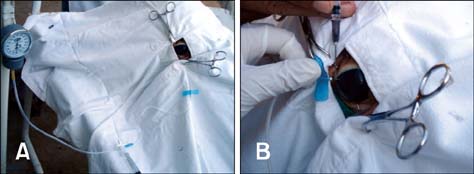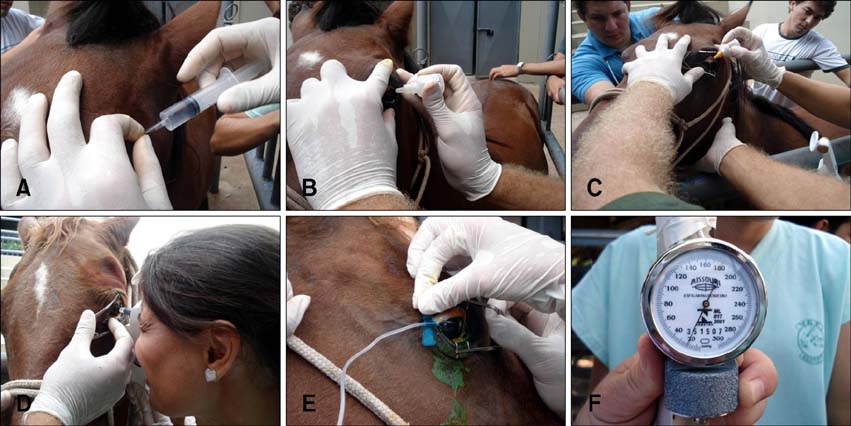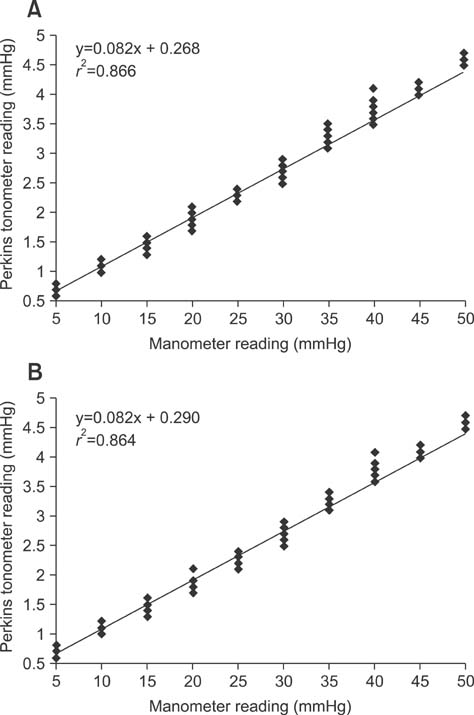J Vet Sci.
2011 Jun;12(2):171-176. 10.4142/jvs.2011.12.2.171.
Evaluation of the Perkins handheld applanation tonometer in horses and cattle
- Affiliations
-
- 1Department of Small Animal Medicine of Veterinary Hospital, University of Oeste Paulista, Rodovia Raposo Tavares, km 572, CEP 19001-970, Presidente Prudente, Brazil. silviafranco@unoeste.br
- 2Faculty of Veterinary Medicine, University of Oeste Paulista, Rodovia Raposo Tavares, km 572, CEP 19001-970, Presidente Prudente, Brazil.
- 3Department of Large Animal Medicine of Veterinary Hospital, University of Oeste Paulista, Rodovia Raposo Tavares, km 572, CEP 19001-970, Presidente Prudente, Brazil.
- KMID: 1106560
- DOI: http://doi.org/10.4142/jvs.2011.12.2.171
Abstract
- The objective of this study was to evaluate and validate the accuracy of the Perkins handheld applanation tonometer for measuring intraocular pressure (IOP) in horses and cattle. Both eyes of 10 adult horses and cattle were evaluated in a postmortem study. The eyes from 10 clinically normal adult horses and cattle were also examined after bilateral auriculopalpebral nerve block and topical anesthesia for an in vivo study. IOP was measured postmortem using direct manometry (measured with an aneroid manometer) and tonometry (measured with a Perkins handheld applanation tonometer). The correlation coefficients (r2 ) for the data from the postmortem manometry and Perkins tonometer study were 0.866 for horses and 0.864 for cattle. In the in vivo study, IOP in horses was 25.1 +/- 2.9 mmHg (range 19.0~30.0 mmHg) as measured by manometry and 23.4 +/- 3.2 mmHg (range 18.6~28.4 mmHg) according to tonometry. In cattle, IOP was found to be 19.7 +/- 1.2 mmHg (range 18.0~22.0 mmHg) by manometry and 18.8 +/- 1.7 mmHg (range 15.9~20.8 mmHg) by tonometry. There was a strong correlation between the IOP values obtained by direct ocular manometry and the tonometer in both horses and cattle. Our results demonstrate that the Perkins handheld tonometer could be an additional tool for accurately measuring IOP in equine and bovine eyes.
MeSH Terms
Figure
Reference
-
1. Andrade SF, Cremonezi T, Zachi CAM, Lonchiati CF, Amatuzzi JD, Sakamoto KP, Mello PAA. Evaluation of the Perkins® handheld applanation tonometer in the measurement of intraocular pressure in dogs and cats. Vet Ophthalmol. 2009. 12:277–284.
Article2. Brooks DE, Ryan J. Gelatt KN, editor. Equine ophthalmology. Veterinary Ophthalmology. 1999. 3rd ed. Philadelphia: Lippincott Williams & Wilkins;1097–1115.3. Dziezyc J, Millichamp NJ, Smith WB. Comparison of applanation tonometers in dogs and horses. J Am Vet Med Assoc. 1992. 201:430–433.4. Frenkel REP, Hong YJ, Shin DH. Comparison of the Tono-Pen to the Goldmann applanation tonometer. Arch Ophthalmol. 1988. 106:750–753.
Article5. Gelatt KN, Peiffer RL Jr, Gum GG, Gwin RM, Erickson JL. Evaluation of applanation tonometers for the dog eye. Invest Ophthalmol Vis Sci. 1977. 16:963–968.6. Gerometta R, Podos SM, Candia OA, Wu B, Malgor LA, Mittag T, Danias J. Steroid-induced ocular hypertension in normal cattle. Arch Ophthalmol. 2004. 122:1492–1497.
Article7. Gum GG, Gelatt KN, Miller DN, Mackay EO. Intraocular pressure in normal dairy cattle. Vet Ophthalmol. 1998. 1:159–161.
Article8. Hammond BR, Bhattacherjee P. Calibration of the Alcon applanation pneumatonograph and Perkins tonometer for use in rabbits and cats. Curr Eye Res. 1984. 3:1155–1158.
Article9. Kalesnykas G, Uusitalo H. Comparison of simultaneous readings of intraocular pressure in rabbits using Perkins handheld, Tono-Pen XL, and TonoVet tonometers. Graefes Arch Clin Exp Ophthalmol. 2007. 245:761–762.
Article10. Knollinger AM, La Croix NC, Barrett PM, Miller PE. Evaluation of a rebound tonometer for measuring intraocular pressure in dogs and horses. J Am Vet Med Assoc. 2005. 227:244–248.
Article11. Leiva M, Naranjo C, Peña MT. Comparison of the rebound tonometer (ICare®) to the applanation tonometer (Tonopen XL®) in normotensive dogs. Vet Ophthalmol. 2006. 9:17–21.
Article12. Lim KS, Wickremasinghe SS, Cordeiro MF, Bunce C, Khaw PT. Accuracy of intraocular pressure measurements in New Zealand white rabbits. Invest Ophthalmol Vis Sci. 2005. 46:2419–2423.
Article13. Lingel NJ, Coffey B. Effects of disinfecting solutions recommended by the Centers for Disease Control on Goldmann tonometer biprisms. J Am Optom Assoc. 1992. 63:43–48.14. Maggs DJ. Maggs DJ, Miller PE, Ofri R, editors. Basic diagnostic techniques. Slatter's Fundamentals of Veterinary Ophthalmology. 2007. 4th ed. St. Louis: Saunders;81–106.
Article15. Miller PE, Pickett JP, Majors LJ. Evaluation of two applanation tonometers in horses. Am J Vet Res. 1990. 51:935–937.16. Miller PE. Maggs DJ, Miller PE, Ofri R, editors. The glaucomas. Slatter's Fundamentals of Veterinary Ophthalmology. 2007. 4th ed. St. Louis: Saunders;230–257.
Article17. Passaglia CL, Guo X, Chen J, Troy JB. Tono-Pen XL® calibration curves for cats, cows and sheep. Vet Ophthalmol. 2004. 7:261–264.
Article18. Pickett JP, Ryan J. Equine glaucoma: a retrospective study of 11 cases from 1988 to 1993. Vet Med. 1993. 88:756–763.19. Schottenstein EM. Ritch R, Shields MB, Krupin T, editors. Intraocular pressure and tonometry. The Glaucomas: Basic Sciences. 1996. 2nd ed. St. Louis: Mosby;407–428.20. Takatsuji K, Sato Y, Izuka S, Nakatani H, Nakamura A. Animal model of closed angle glaucoma in albino mutant quails. Invest Ophthalmol Vis Sci. 1986. 27:396–400.21. Van Der Woerdt A, Gilger BC, Wilkie DA, Strauch SM. Effect of auriculopalpebral nerve block and intravenous administration of xylazine on intraocular pressure and corneal thickness in horses. Am J Vet Res. 1995. 56:155–158.22. Vote BJ, Elder MJ. Cyanoacrylate glue for corneal perforations: a description of a surgical technique and a review of the literature. Clin Experiment Ophthalmol. 2000. 28:437–442.
Article23. Wilkie DA, Gilger BC. Equine glaucoma. Vet Clin North Am Equine Pract. 2004. 20:381–391.
Article
- Full Text Links
- Actions
-
Cited
- CITED
-
- Close
- Share
- Similar articles
-
- Clinical Evaluation of A Noncontact Applanation Tonometer
- Clinical Evaluation of New Handheld Air Impulse Tonometer
- Postural Effect on the Intraocular Pressure: Clinical application of Perkins applanation tonometer, 1st report
- The Influence of Central Corneal Thickness on Intraocular Pressures Measured with Goldmann Applanation Tonometer and Non-contact Tonometer
- Clinical Comparision of the ProTon and the Goldmann Applanation Tonometer





